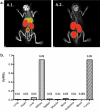Targeted alpha therapy using short-lived alpha-particles and the promise of nanobodies as targeting vehicle
- PMID: 27145158
- PMCID: PMC4940885
- DOI: 10.1080/14712598.2016.1185412
Targeted alpha therapy using short-lived alpha-particles and the promise of nanobodies as targeting vehicle
Abstract
Introduction: The combination of a targeted biomolecule that specifically defines the target and a radionuclide that delivers a cytotoxic payload offers a specific way to destroy cancer cells. Targeted radionuclide therapy (TRNT) aims to deliver cytotoxic radiation to cancer cells and causes minimal toxicity to surrounding healthy tissues. Recent advances using α-particle radiation emphasizes their potential to generate radiation in a highly localized and toxic manner because of their high level of ionization and short range in tissue.
Areas covered: We review the importance of targeted alpha therapy (TAT) and focus on nanobodies as potential beneficial vehicles. In recent years, nanobodies have been evaluated intensively as unique antigen-specific vehicles for molecular imaging and TRNT.
Expert opinion: We expect that the efficient targeting capacity and fast clearance of nanobodies offer a high potential for TAT. More particularly, we argue that the nanobodies' pharmacokinetic properties match perfectly with the interesting decay properties of the short-lived α-particle emitting radionuclides Astatine-211 and Bismuth-213 and offer an interesting treatment option particularly for micrometastatic cancer and residual disease.
Keywords: Cancer; astatine-211; bismuth-213; nanobody; radionuclide labeling; targeted alpha therapy; targeting vehicles.
Figures



References
-
- Middendorp M, Grünwald F. Update on recent developments in the therapy of differentiated thyroid cancer. Semin Nucl Med. 2010;40(2):145–152. Elsevier Inc. - PubMed
-
- Henriksen G, Fisher DR, Roeske JC. Targeting of osseous sites with alpha-emitting 223Ra: comparison with the beta-emitter 89Sr in mice. J Nucl Med. 2003;44(2):252–259. - PubMed
-
- Van Dodewaard-de Jong J, Oprea-Lager D, Hooft L. Radiopharmaceuticals for palliation of bone pain in patients with castration-resistant prostate cancer metastatic to bone: a systematic review. Eur Urol. 2015 European Association of Urology. - PubMed
-
- Kwekkeboom DJ, Mueller-Brand J, Paganelli G. Overview of results of peptide receptor radionuclide therapy with 3 radiolabeled somatostatin analogs. J Nucl Med. 2005;46(1):62S–6S. - PubMed
Publication types
MeSH terms
Substances
LinkOut - more resources
Full Text Sources
Other Literature Sources
Molecular Biology Databases
